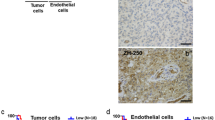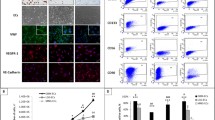Abstract
In order to clarify the role of endothelin B receptors (ETBRs) in gliomas, we analyzed cell cultures and surgical specimens of gliomas using RT-PCR and immunohistochemistry. RT-PCR measured the absolute expression of ETBR mRNA in twelve samples, which included gliomas that were classified using the World Health Organization (WHO) classification system Grade I–IV, as well as two glioblastoma cell lines (CCF-STTG1 and U87-MG). Using immunohistochemistry, 77 glioma specimens were evaluated for their expression of ETBR and infiltrating T lymphocytes, including an analysis of cytotoxic T cells (CTLs) and regulatory T lymphocytes (Tregs). The number of ETBR-positive vessels in the glioblastomas (Grade IV) was significantly higher than in other grades of gliomas (comparisons to Grade IV, Grade I: p = 0.0323, Grade II: p = 0.0009, Grade III: p = 0.0273). The ETBR expression rate (defined as the number of ETBR-positive blood vessels divided by the total number of blood vessels) in the glioblastomas was higher than the ETBR expression rate in the low-grade gliomas (compared to Grade IV, Grade I: p = 0.0132, Grade II: p = 0.0018, Grade III: p = 0.0745). In addition, the cases which had an ETBR expression rate of 50 % or higher exhibited fewer infiltrating CTLs and more infiltrating Tregs compared to the cases with an ETBR expression rate <50 % (CTLs: p = 0.0342; Tregs: p = 0.0175). Isocitrate dehydrogenase 1 (IDH-1) mutations were identified in 21 cases, but there was no correlation between ETBR expression and IDH-1 mutations for any WHO grade. These results suggest that ETBR expression during neo-angiogenesis may interfere with the homing of CTLs around the tumor and be involved in the immune escape mechanism of gliomas.




Similar content being viewed by others
References
Yanagisawa M, Kurihara H, Kimura S et al (1988) A novel potent vasoconstrictor peptide produced by vascular endothelial cells. Nature 332:411–415
Inoue A, Yanagisawa M, Kimura S et al (1989) The human endothelin family: three structurally and pharmacologically distinct isopeptides predicted by three separate genes. Proc Natl Acad Sci USA 86:2863–2867
Ahmed SI, Thompson J, Coulson JM, Woll PJ (2000) Studies on the expression of endothelin, its receptor subtypes, and converting enzymes in lung cancer and in human bronchial epithelium. Am J Respir Cell Mol Biol 22:422–431
Rosano L, Varmi M, Salani D et al (2001) Endothelin-1 induces tumor proteinase activation and invasiveness of ovarian carcinoma cells. Cancer Res 61:8340–8346
Kusuhara M, Yamaguchi K, Nagasaki K et al (1990) Production of endothelin in human cancer cell lines. Cancer Res 50:3257–3261
Nelson JB, Chan-Tack K, Hedican SP et al (1996) Endothelin-1 production and decreased endothelin B receptor expression in advanced prostate cancer. Cancer Res 56:663–668
Shankar A, Loizidou M, Aliev G et al (1998) Raised endothelin 1 levels in patients with colorectal liver metastases. Br J Surg 85:502–506
MacCumber MW, Ross CA, Snyder SH (1990) Endothelin in brain: receptors, mitogenesis, and biosynthesis in glial cells. Proc Natl Acad Sci USA 87:2359–2363
Giaid A, Gibson SJ, Herrero MT et al (1991) Topographical localisation of endothelin mRNA and peptide immunoreactivity in neurones of the human brain. Histochemistry 95:303–314
Sone M, Takahashi K, Totsune K et al (2000) Expression of endothelin-1 and endothelin receptors in cultured human glioblastoma cells. J Cardiovasc Pharmacol 36:S390–S392
Shen C, Yang L, Yuan X (2011) Endothelin B receptor expression in human astrocytoma: association with clinicopathological variables and survival outcomes. Int J Neurosci 121:626–631
Kandalaft LE, Facciabene A, Buckanovich RJ, Coukos G (2009) Endothelin B receptor, a new target in cancer immune therapy. Clin Cancer Res 15:4521–4528
Buckanovich RJ, Facciabene A, Kim S et al (2008) Endothelin B receptor mediates the endothelial barrier to T cell homing to tumors and disables immune therapy. Nat Med 14:28–36
Floess S, Freyer J, Siewert C et al (2007) Epigenetic control of the Foxp3 locus in regulatory T cells. PLoS Biol 5:e38
Ohkura N, Hamaguchi M, Morikawa H et al (2012) T cell receptor stimulation-induced epigenetic changes and Foxp3 expression are independent and complementary events required for Treg cell development. Immunity 37:785–799
Ponzoni M, Berger F, Chassagne-Clement C et al (2007) Reactive perivascular T-cell infiltrate predicts survival in primary central nervous system B-cell lymphomas. Br J Haematol 138:316–323
Wang JJ, Sun XC, Hu L et al (2013) Endoglin (CD105) expression on microvessel endothelial cells in juvenile nasopharyngeal angiofibroma: tissue microarray analysis and association with prognostic significance. Head Neck 35:1719–1725
Sugita Y, Takase Y, Mori D, Tokunaga O, Nakashima A, Shigemori M (2007) Endoglin (CD 105) is expressed on endothelial cells in the primary central nervous system lymphomas and correlates with survival. J Neurooncol 82:249–256
Louis DN, Ohgaki H, Wiestler OD et al (2007) The 2007 WHO classification of tumors of the central nervous system. Acta Neuropathol 114(2):97–109
Yan H, Parsons DW, Jin G et al (2009) IDH1 and IDH2 mutations in glioma. N Engl J Med 360:765–773
Yamada T, Ohtani S, Sakurai T et al (2006) Reduced expression of the endothelin receptor type B gene in piebald mice caused by insertion of a retroposon-like element in intron 1. J Biol Chem 281:10799–10807
Komatani H, Sugita Y, Arakawa F, Ohshima K, Shigemori M (2009) Expression of CXCL12 on pseudopalisading cells and proliferating microvessels in glioblastomas: an accelerated growth factor in glioblastomas. Int J Oncol 34:665–672
Naidoo V, Naidoo S, Mahabeer R, Raidoo DM (2005) Localization of the endothelin system in human diffuse astrocytomas. Cancer 104:1049–1057
Koseki C, Imai M, Hirata Y, Yanagisawa M, Masaki T (1989) Autoradiographic distribution in rat tissues of binding sites for endothelin: a neuropeptide? Am J Physiol 256:R858–R866
Liu J, Chen R, Casley DJ, Nayler WG (1990) Ischemia and reperfusion increase 125I-labeled endothelin-1 binding in rat cardiac membranes. Am J Physiol 258:H829–H835
Fujimori A, Yanagisawa M, Saito A et al (1990) Endothelin in plasma and cerebrospinal fluid of patients with subarachnoid haemorrhage. Lancet 336:633
Yao Y, Kubota T, Takeuchi H et al (2005) Prognostic significance of microvessel density determined by an anti-CD105/endoglin monoclonal antibody in astrocytic tumors: comparison with an anti-CD31 monoclonal antibody. Neuropathology 25:201–206
Behrem S, Zarkovic K, Eskinja N et al (2005) Endoglin is a better marker than CD31 in evaluation of angiogenesis in glioblastoma. Croat Med J 45:417–422
Sugita Y, Terasaki M, Nakashima S et al (2015) The perivascular microenvironment in primary central nervous system lymphomas: the role of chemokines and the endothelin B receptor. Brain Tumor Pathol 32:41–48
Felgar RE, Macon WR, Kinney MC, Roberts S, Pasha T, Salhany KE (1997) TIA-1 expression in lymphoid neoplasms. Identification of subsets with cytotoxic T lymphocyte or natural killer cell differentiation. Am J Pathol 150:1893–1900
Mruk DD, Xiao X, Lydka M, Li MW, Bilinska B, Cheng CY (2013) Intercellular adhesion molecule 1: recent findings and new concepts involved in mammalian spermatogenesis. Semin Cell Dev Biol 29:43–54
Grimmig T, Kim M, Germer CT, Gasser M, Waaga-Gasser AM (2013) The role of Foxp3 in disease progression in colorectal cancer patients. Oncoimmunology 2:e24521
Wainwright DA, Balyasnikova IV, Chang AL et al (2012) IDO expression in brain tumors increases the recruitment of regulatory T cells and negatively impacts survival. Clin Cancer Res 18:6110–6121
Kutlu GE, Chantale L, Narendra PS, Esma S, Haval S (2007) CD4+CD25+ T regulatory cells dominate multiple immune evasion mechanisms in early but not late phases of tumor development in a B cell lymphoma model. J Immunol 178:6840–6848
Aguilar LK, Guzik BW, Aguilar-Cordova E (2011) Cytotoxic immunotherapy strategies for cancer: mechanisms and clinical development. J Cell Biochem 112:1969–1977
Kawakami Y, Yaguchi T, Sumimoto H et al (2013) Improvement of cancer immunotherapy by combining molecular targeted therapy. Front Oncol 3(136):1–7
Terasaki M, Shibui S, Narita Y et al (2011) Phase I trial of a personalized peptide vaccine for patients positive for human leukocyte antigen–A24 with recurrent or progressive glioblastoma multiforme. J Clin Oncol 29:337–344
Ricci-Vitiani L, Pallini R, Biffoni M et al (2010) Tumour vascularization via endothelial differentiation of glioblastoma stem-like cells. Nature 468:824–828
Acknowledgement
We thank Professor Elias Campo and his department members for providing antibodies. This work was supported by JSPS KAKENHI Grant Number 24500427.
Author information
Authors and Affiliations
Corresponding author
Ethics declarations
Conflict of interest
The authors declare no conflicts of interest.
Research involving in Human and animal rights
All procedures performed in studies involving human participants were in accordance with the ethical standards of the institutional and/or national research committee and with the 1964 Helsinki Declaration and its later amendments or comparable ethical standards. For this type of study, formal consent was not required.
Rights and permissions
About this article
Cite this article
Nakashima, S., Sugita, Y., Miyoshi, H. et al. Endothelin B receptor expression in malignant gliomas: the perivascular immune escape mechanism of gliomas. J Neurooncol 127, 23–32 (2016). https://doi.org/10.1007/s11060-015-2017-5
Received:
Accepted:
Published:
Issue Date:
DOI: https://doi.org/10.1007/s11060-015-2017-5




